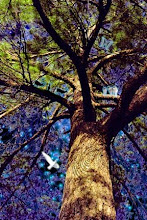With a little patience, some old-fangled equipment, and a lot of yarn,
Lucille Hair has become a living legend for Cherokee weavers.
| It's just before 11 a.m. on a Thursday, and the Cherokee weavers are a little slow getting started. They're leaning back in their chairs, sipping at Mountain Dews, savoring the sunlight that pours through the tall, open windows that surround their spacious shop. A wood stove crackles away in a corner. The Cherokee weavers could be working, making a colorful assortment of blankets, rugs, and whatnot -but they're not. They just don't feel like it. "Every day, we act like we've never seen each other," said Wynona Dreadfulwater. "We just sit around this table and talk. Then again, we're a little on the lazy side." "We're our own boss," said Lucille Hair. "We do what we want to do." And who's to argue? Living history, and living legends, are hard to find. They should do as they like. Though others have come, they've also gone. Weaving isn't for everyone, it seems. "People think it's easy," said Dreadfulwater. "But it's not easy. We've had a lot of people start blankets that we've had to finish." "It's a lot of work, but it's not hard work," said Hair. "I guess I just like to weave." Bill Ames, an instructor at Sequoyah High School, taught Hair and nine other Cherokee women the art of weaving. They made blankets, mostly, and Ames helped the women sell their wares. It was a way to make a money, at a time when very few women worked. Ames also managed to talk the U.S. government out of an old barracks building at Camp Gruber, moved it to Briggs, and renovated it with the help of some of his students. He even got a steal on some used looms from the Chilocco Indian school, north of Ponca City. "At one time, there were six looms in here, but people started taking them. They'd put them in their houses," said Hair. She shrugs: "Who knows where they are now." When Ames left to take a job on a reservation in Montana, he gave the weaving ladies one last directive. Of the original six looms, only three remain, their hardwood frames polished smooth by a lifetime of busy hands. Hair shows them off, proudly. She knows them well, as well as she knows any of her children. They're beautiful antiques, dinosaurs of the early industrial age: Wires and pedals and giant weights to keep the fabric taught, a spindle of yarn as big as a filing cabinet. Everything on a loom seems to move, and when they're all going, they can create a cacophony. "You have to like doing it," Hair said. "If you don't like it, you're not going to learn. There are people who learn how, but they quit. Then they forget how it's done." She gives a quick tutorial on the process of weaving. After loading 20 spools of yarn for the body of a blanket, and 10 spools for a border, they wind them on a giant warp-wheel. That wheel is then placed on the loom, the yarn threaded, and the actual weaving process begins. She demonstrates the sequence of pushing the pedals that create different types of weave: straight, herringbone, diamond, twill. "One, two, three, four, then three, three, four, then one, three, four ... it's easy to get confused, and lose your place," she said. "You get distracted." A blanket can take days to finish, and usually sells for around $100. "You can't make a living off it," said Hair. "There's no place to sell them, really." There's no sign outside the building. The weavers get business through word-of-mouth, and from orders taken at the Cherokee Heritage Center. Their latest coup was selling three blankets to Crystal Gayle, at the recent Cherokee Medal of Honor awards, where Hair was an honoree. "She said she'd buy some more," said Dreadfulwater. "She gave us her phone number in Nashville, and mom's going to give her a call." Hair also donates her blankets to charitable causes. One was raffled to raise funds to send the Cherokee Children's Choir - of which one of her grandsons is a part - to Ground Zero in New York City. Despite her age, Hair gets around like a woman who still has at least a few more blankets in mind. After going through triple-bypass surgery a few years ago, she was back working on the loom in no time. "Two weeks later she was out pulling weeds in the garden," said Dreadfulwater. "I said, 'get back on the porch!' but she wouldn't listen. She doesn't listen." Which may all be a part of Hair's legacy. She doesn't have to listen, and she does what she likes. After all, she's a living legend, living out a part of history. |
| ©Tahlequah Daily Press 2002 |





No comments:
Post a Comment